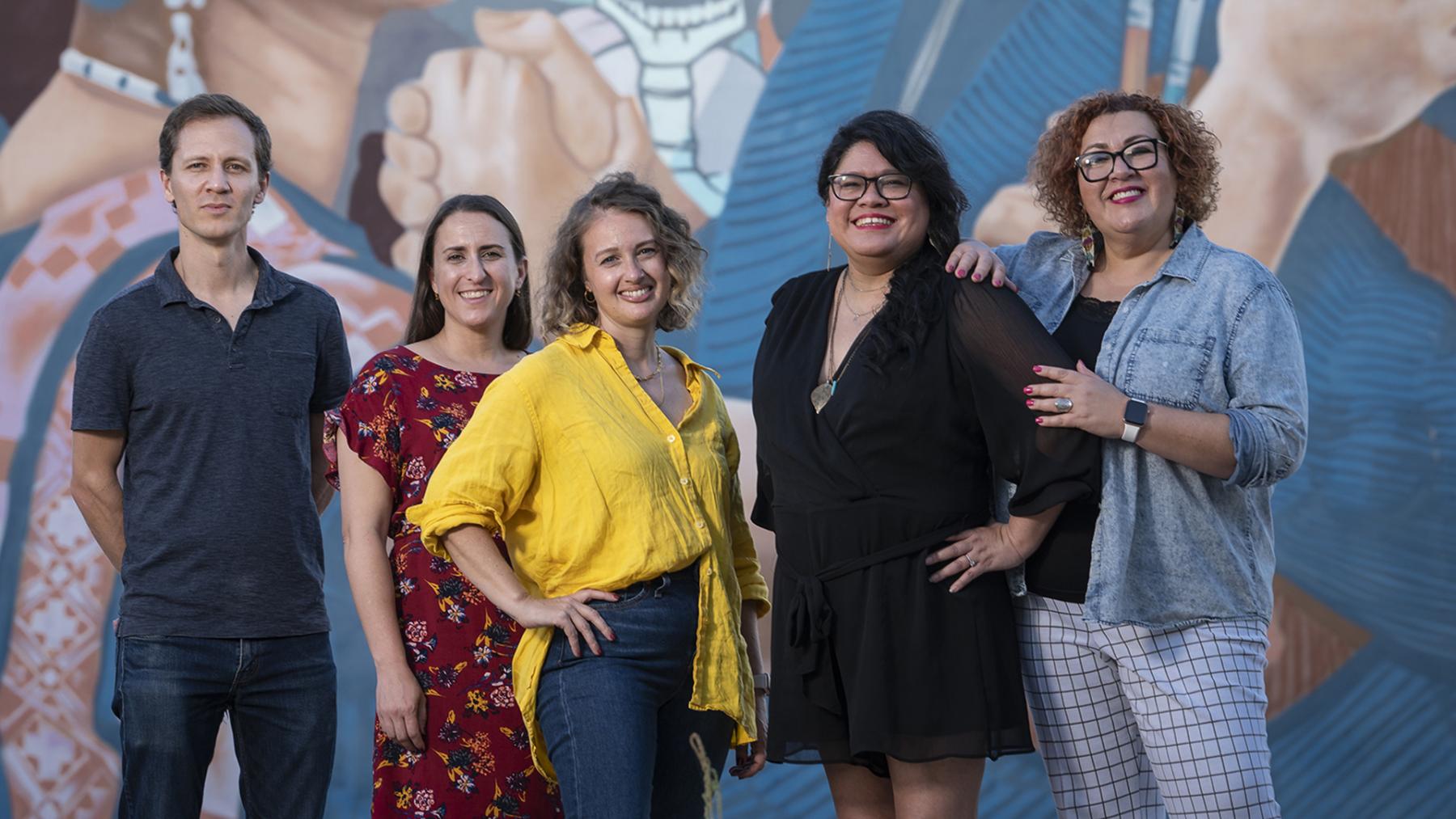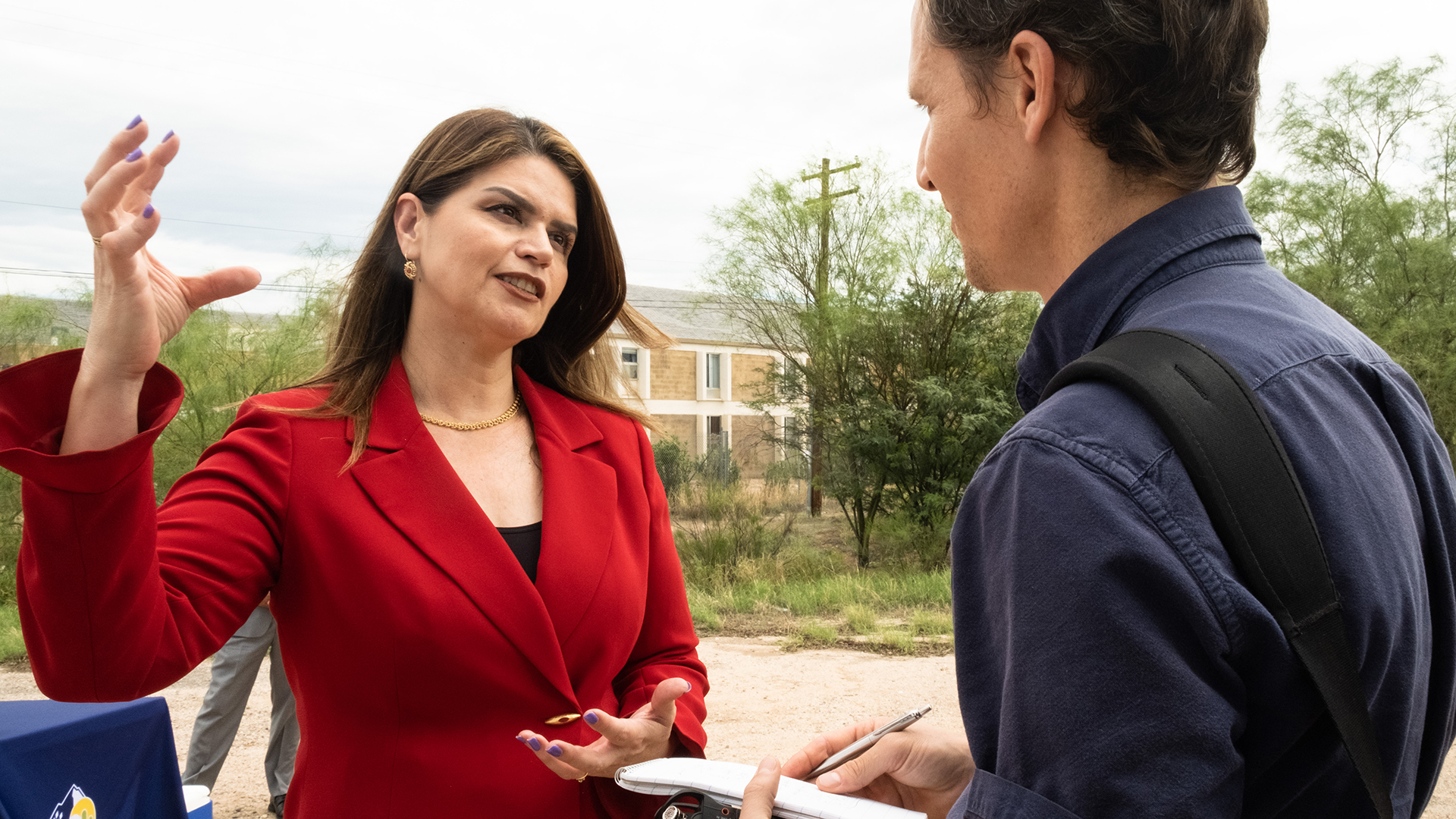
Newsroom

Will philanthropy power the future of journalism? A look into nonprofit newsroom AZ Luminaria
April 11, 2023 — The expanding domain of nonprofit journalism, which is frequently overshadowed by prominent corporate news organizations, is gaining traction within the media industry, including in Arizona. Launched in March 2022, AZ Luminaria is a Tucson-based digital, nonprofit newsroom that is dedicated to truly local news and community-centered journalism.
AZ Luminaria emerged from the collaboration of three women with extensive community journalism experience, aiming to establish a platform for local news that not only informs but also motivates individuals to effect change. The platform adopts a solutions-oriented approach to journalism.
Becky Pallack and Irene McKisson (second and third from left in the photo above) amassed experience of approximately 18 years at the Arizona Daily Star in Tucson before establishing AZ Luminaria. During that time, they established a startup publication inside the Star, "This Is Tucson," which provided them with a firsthand understanding of news entrepreneurship, ultimately contributing to the development of AZ Luminaria.
“And so part of the problem that we left to try and solve was to think about the business model differently, and to think about the pay structure for journalists differently because we could see that those were some issues,” McKisson said.
As they strategized ways to build their newsroom, they settled on a nonprofit business model. This opened up philanthropy as a revenue stream that they couldn't access as a for-profit organization.
“We really believe that news is a public service, that news should be free, that it should be open to everybody, and that part of the issue that we're seeing in our democracy, and with misinformation and disinformation is that their pay walls are in front of a lot of the information that people need to be able to engage in their communities, and so from that perspective, a nonprofit model also made a lot of sense,” said McKisson.
The revenue structure of AZ Luminaria includes grants, underwriters, live events and individual donors, with the latter two categories serving as the primary sources of funding. A membership program facilitates contributions from major donors and individual donors.
“I think that piece of it's really important too because it means that we're accountable to our communities in a financial way.”
The rise of nonprofit news organizations
Nonprofit news represents a hopeful prospect for the future of a disrupted industry, offering an inclusive, innovative and sustainable approach that serves the public. By typically eliminating paywalls and subscription fees in favor of voluntary donations, most nonprofit news organizations ensure that critical news and information are accessible to all, regardless of financial means. Furthermore, nonprofit news is dedicated to the communities it serves, supported by them, and committed to providing a platform for their voices to be heard.
Where traditional news sources cover a broad range of topics, nonprofit news outlets tend to focus specifically on one subject that resonates with their audience. The Institute for Nonprofit News (INN), an organization that helps ensure the impartiality and credibility of independent news outlets like AZ Luminaria, reports that approximately 70% of nonprofit newsrooms concentrate on local, regional or state news, while approximately 20% of nonprofit newsrooms dedicate themselves to exploring a single topic in greater depth.
According to a report by the Pew Research Center, the number of digital nonprofit outlets that emerged between 1987 and 2012 amounted to 172, with a majority of 71% being formed between 2008 and 2012. As a response to this trend, many of these groups joined forces to create the Institute for Nonprofit News, whose members are typically structured as 501c(3) organizations. INN Network members prioritize impartial reporting over advocating for any particular policy or cause, with a focus on informing their respective communities and defending people's right to access information and express themselves. Additionally, they aim to promote a news media that is more diverse and representative of the communities it serves.
The INN Index for 2022 reveals that the growth in the number of nonprofit news outlets is being driven by smaller, local news organizations. Approximately 40% of nonprofit news organizations are now local, which is a significant increase from the roughly 20% seen in 2017.
Startups funded by philanthropy aren’t the only organizations behind the nonprofit news trend. Some legacy for-profit news organizations have become nonprofits, including the venerable Philadelphia Inquirer, which was donated by its owner to the Lenfest Institute in 2016. In 2019, the 148-year-old Salt Lake Tribune became the first legacy newspaper granted 501(c)(3) status by the IRS. The Chicago Sun-Times, after multiple ownership changes and a bankruptcy since 2009, was acquired by the nonprofit Chicago Public Media in 2022.
Getting to know “Lou”
Empathy interviews played a huge role in helping McKisson and Pallack develop the identity of AZ Luminaria as a news outlet. An empathy interview employs a human-centered methodology to comprehend the emotions and encounters of individuals, accumulating insights that are typically not readily apparent. Using this methodology, McKisson and Pallack conducted interviews with 25 individuals to discern their interests, find out the gaps in traditional news coverage, and determine the issues that evoke their passions.
“We asked them, what's the topic that you're super passionate about but you can't find cool information about? What you would hold a sign for and like, what would the sign say? And then, how do you get local information about that thing?” McKisson said.
This process gave birth to “Lou.” Lou is the target audience for AZ Luminaria.
“Lou is somebody who wants to take action in their community, and they're having trouble getting the local information that they need to do that they are really interested in,” McKisson said. “When you're assigning a story and you're like, would you read this? It's really a powerful way to think about it, to humanize, and that's what we try to do with everything.”
Identifying Lou’s needs, interests and passions aided AZ Luminaria in establishing its beats. At this point, McKisson and Pallack had laid out the basic foundation of a nonprofit newsroom and decided to bring in Dianna Náñez (second from right in the photo at top), the third co-founder of AZ Luminaria. Náñez is an investigative journalist, narrative writer/editor and storytelling coach. She drives the editorial strategy for AZ Luminaria.

AZ Luminaria’s stories adopt a solution-oriented approach, which partly stemmed from the interviews they conducted, revealing a weariness among people towards breaking headlines that solely highlight issues without providing possible solutions. These are the people actively seeking means to effect change and make a tangible difference.
The journalism approach of AZ Luminaria, centered on solutions, not only provides the audience with significant news but also promotes community involvement. The platform prioritizes extensive and comprehensive news stories that establish a link between the community and the larger state while simultaneously fostering local connections.
Traditional journalism often refrains from guiding how to take action, as it may be viewed as advocacy which could compromise journalistic impartiality. However, AZ Luminaria embraces a distinctive approach, ensuring that its audience not only understands the issue at hand but also perceives possible solutions. According to McKisson, the platform's reporting methodology, dubbed "slow news," focuses on comprehensive coverage, steering clear of breaking news, quick press releases, and popular topics such as sports. The platform prioritizes detailed and in-depth reporting.
Another aspect that AZ Luminaria makes sure to include in its storytelling process is the inclusion of the Spanish language. By writing stories in Spanish as well as English, AZ Luminaria is inclusive of the Spanish-speaking public in Tucson, 26.87% of the population.
AZ Luminaria is a nonprofit news organization that adheres to the standard structure of a newsroom by having an editorial board. It also has a nonprofit executive board that operates independently. The decisions made by the executive board do not hamper the editorial board's independence. To uphold transparency, AZ Luminaria follows a donor transparency policy that mandates public disclosure of donations exceeding $5,000 annually. This policy serves to reinforce the public's confidence in AZ Luminaria's status as a news organization and nonprofit entity.
“What we’re measuring is impact instead of page views,” McKisson said. AZ Luminaria measures success by surveying their readers on whether the outlet’s stories helped them take action and give them more knowledge.
“There's this really welcoming generous community of other nonprofit news organizations across the U.S.and they just give you things. Coming out of a for-profit newsroom, where nobody wants to tell you anything like everything is proprietary and you can't talk about your numbers, in the nonprofit world, it's very generous, and everybody is really open to sharing.”
AZ Luminaria benefits from the compassion intrinsic to the nonprofit sector, where organizations are inclined towards contributing and supporting the community, rather than being driven solely by financial gain. As a nonprofit newsroom, AZ Luminaria has been able to leverage this ethos to further its mission.
Despite being a relatively new addition to the journalism landscape, AZ Luminaria has already established a strong presence among individuals who are passionate about their communities and wish to take an active role in shaping their future. Unlike some news organizations that prioritize profit over purpose, AZ Luminaria's focus is on rebuilding public trust in journalism while also inspiring collective action. By prioritizing attentive listening and ongoing education, AZ Luminaria aims to provide guidance and encouragement to those who seek to effect positive change in their local communities.
“When you're mission-driven, you can make decisions that benefit your community, not decisions that benefit your bottom line.”
Story by Riva Surana, ASU Lodestar Center. Photos courtesy AZ Luminaria.
This story is part of the Nonprofit Social Innovation Hub, where organizations can find ideas and inspiration from their colleagues in the nonprofit and philanthropic community, from new operating models to fresh technology solutions.